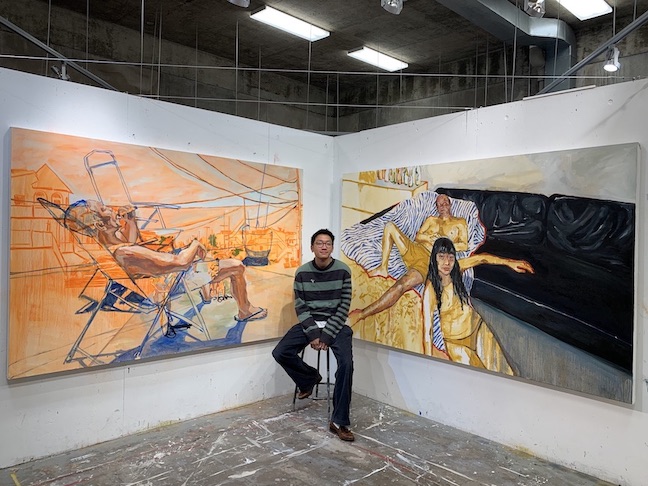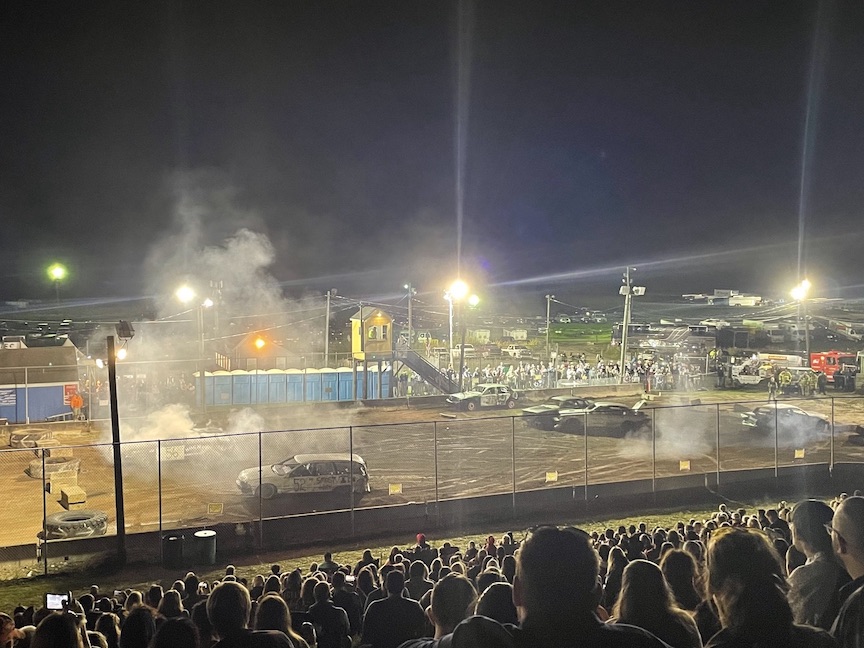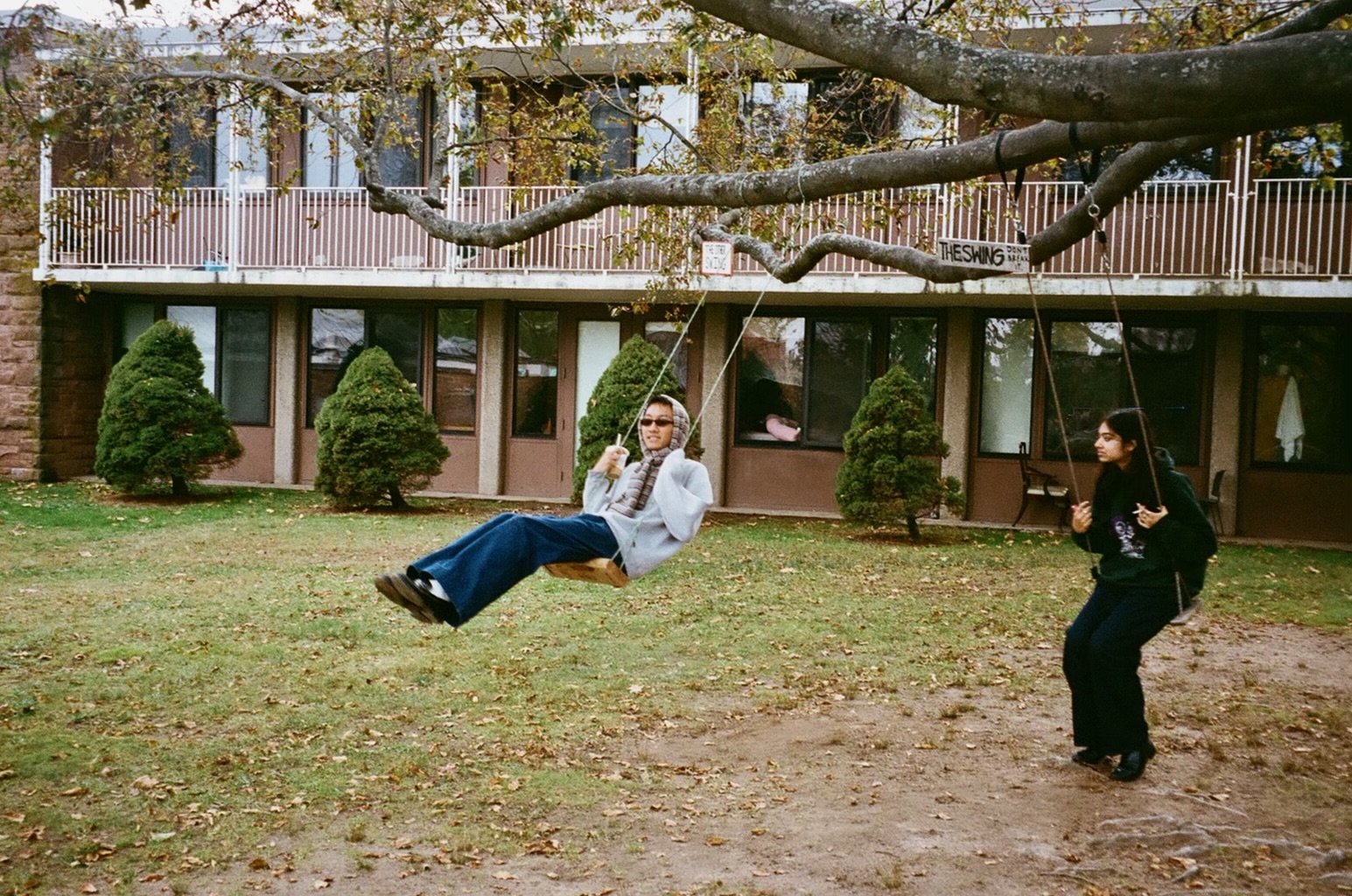Dylan Ng ’24 may be one of the most dynamic artists at Wesleyan, utilizing mediums from painting to photography to graphic design to express the inner workings of his mind. You will likely find him biking around campus, walking quickly—in the direction of the Center for the Fine Arts (CFA)—with an iced Americano in hand, or making a coffee for one of his friends at Espwesso. Wherever Ng goes, he carries an infectious energy—something everyone on campus wants to be around. Ng sat down with The Argus after closing up shop at Espwesso to discuss his many creative pursuits and his ever-evolving identity as an artist and student.

The Argus: Why do you think you were nominated?
Dylan Ng: I have no idea why I was nominated.
A: Can you talk about your nomination from sophomore year? Someone wrote, “Dylan is the most fantastic presence on campus. He’s so involved in the studio art [world] as well as just making the environment of the community happy at all times. He is consistently well-known as someone who is so friendly and all-around just a great vibe.”
DN: I hope I’m a friendly presence on campus and I hope I bring good vibes. Half the time I’m brain-dead walking around. My nomination sophomore year was a silly moment. But I’m really honored to be WesCeleb this time. I’ve literally told everyone about it. It’s a nice little thing to be reminded that your presence on this campus and to the community [matters] and, I guess, [I have had] a good impact on it, which is really nice to hear.
A: Can you talk about someone that you are glad you got to know during your time here?
DN: There’s so many people. I think I had different waves of interaction with people for sure. I think freshman year I kind of stuck to the same people because it was COVID so you kind of had to. And then sophomore year I hung out with the same people. Junior year, I met Jo [Harkless ’24]. We were abroad together in London. I feel like by junior year, I wasn’t really interacting with the amount of people I wanted to. I was just kind of sticking with the same people—which is also so nice. I am really close with all of them. But I think meeting Jo and hanging out with Amanda Swartz [’24] and UG [Shakhnovskaya ’24] and Coco [Brooks ’24] [and] just everyone in London who I usually wouldn’t really hang out with that often [was great]. And then when we got back to campus, I think Jo and UG really introduced me to a lot more people that I’ve gotten pretty close with throughout junior and senior year, which is really nice.
A: Do you have a favorite moment from Wesleyan or an experience that you were really happy you got involved with?
DN: [In September], I went to the Durham County Fair. They have a car derby where cars just crash into each other. It’s a whole state fair [that] takes up like three miles. I went with a lot of friends, and it was just a fun way to get off campus and experience things. But also, getting a coffee with your friend and sitting outside when the weather is nice and talking is always nice. I spend most of my time in the CFA so I usually bring a coffee [there] and sit on the benches with a friend or just by myself and hang out. [I was also in] TERP a few weeks ago which was so fun. It felt really college. I was literally wearing leggings and a speedo and [dancing to] LMFAO.

A: What’s your coffee order? Espwesso? Pi?
DN: Oh, [Espwesso]. I get an Americano. I tried a new one today. I pulled the shot, and then in the milk frother I put the shot, a little bit of water, and ice cubes and then steamed it until the ice cubes melted and it made like a nitro cold brew-type Americano.
[It] has also been a highlight of my year working [at Espwesso], interacting with people, and also just being in a good environment. My friend Cypress [Hubbard-Salk ’24] runs the place, and I think she’s doing a really good job this year. You literally can’t get a table here anymore. She’s really bringing it back.
A: Can you talk about your double major in Studio Art and American Studies and why you chose Wesleyan to pursue painting?
DN: Yeah, it was between Wesleyan and RISD [Rhode Island School of Design]. I came here because I like using my brain in a cerebral manner. I knew art school wouldn’t really do that for me in that way, [and] I didn’t want to just focus on art. Art school is a different environment—it’s a lot more intense and a lot more rigorous, which has its ups, but also you’re gonna be in the studio 10 hours a day, which I don’t think I could do. I knew I’d be able to balance Studio Art and American Studies in a very interesting and thoughtful way. I’m a visual studies concentration within the American Studies major, which really informs the way I do art and informs my art history practice.
I think when you’re surrounded by the same people who think very much like you, it’s kind of hard to get out of that bubble. All of my friends [here] have different majors like sociology, government, econ, and philosophy. In art school after sophomore year, most times you concentrate in one field. But here I was able to finish my painting concentration sophomore year [and] explore all these different mediums. I did photo, printmaking, drawing, and 3D. Wesleyan requires you to do all these things, but the ability to explore helps you inform your concentration. So my printmaking practice informs the way I do art, and photo helps me get reference imagery for my paintings. I think Wesleyan was the right decision.

A: We were looking at your website, and there are album covers and all of these other cool projects. What other projects have you done related to your creativity, art, and academics?
DN: I got really lucky with some of the jobs I’ve done. Before freshman year, I started working for a clothing brand. Now, I think it’s a promoting business, but it got me a lot of jobs. It’s called I Like You, and it’s a very New York City club [brand]. I think my cousin was working for their social media team, and then they [were] asking for a graphic designer. I was 17 [or] 18 [and] was like,“I know how to do that a little bit.” I think that’s the fun part about doing something within the creative field. You’re improving the entire time, [and] that opens up a lot of doors. This summer I worked for a prolific photographer [named] Ryan McGinley, and they’re a massive influence within the contemporary photo world. I got that job through my old boss from I Like You. Also, living in New York City, I’m surrounded by all these creative people. But then the music stuff [is with this girl who went to my high school], Grace Enger, and we were in the same grade. She just hit me up while I was in London and [asked me to] do some graphics, and she [ended up] really liking my stuff.
Branching out and doing work for other people always feels really fun. You meet so many new people out of it. I’ve gotten to go to so many concerts [and see] things I wouldn’t have seen [otherwise]. I think I’m just really lucky, because it wasn’t like I knew how to do half the things. I was just like,“Yeah, I can do that. I’ll figure it out.” But I feel like within art, and I guess any field really, it’s all BS-ing. I also love painting, but [being] realistic, I don’t think I can do painting full time after college. I don’t have a parent who owns a gallery. I need to pay for myself. But I’m never gonna give up [painting].
I think delving into graphic design [or] advertisement or photography or production [and] magazine work [is] more applicable to real life. I’m glad I’ve [gotten into it] a little bit earlier in my life, instead of being thrust into it right after college. As an artist I get burnt out pretty easily with one medium, and I like [to get into] different mediums. So having painting, media work, and digital work, but also having a fine art practice, is nice.
A: Do you want to talk a bit about your thesis?
DN: I tried at the beginning of the semester balancing more outside-of-school work. I had some freelancing gigs in September and October that I was really trying to balance. But then I didn’t have a grasp on anything, and everything felt all over the place, so I just started to focus on my thesis. I also work for Fray Magazine. I’m the head layout designer. My best friends Anika [Kewalramani ’24] and Xandra [Chen ’24] run it. But I’ve been mostly doing my thesis. It’s a painting thesis. It’s hard, like every thesis is. I’m working pretty large, at least six feet in one direction. So most of mine are five-by-seven or five-by-seven-and-a-half, and they’re all oil paintings, which take a lot of time and kind of make me feel awful with all the chemicals.
A: Is there one subject that you’ve found yourself focusing on in your thesis?
DN: I mean, I always love people. I love painting still life too. I think I’ve gotten a lot better at knowing what I like to paint and knowing what I don’t like to paint. I started this painting three weeks ago: I did the first layer, and I [thought] it was a really beautiful beachscape of people biking. It was a beautiful image but, at the same time, the most boring thing ever. It’s not a painting. And I decided I was just going to paint over it because I knew the [people] would be a lot more fun to paint. I love art [because of that]—it’s problem solving.
As an Asian gay man, my art is going to be inherently political because it all derives from the individual or the subject. But also, when art is fully dependent on the politics of the self or of its subject, I don’t like that because I feel like the politics derives from the artist rather than the subject matter. I mean, there is such a thing as political art. [But], I feel like it’s also just art, it’s not that deep. I like to think about it in a deep way, but also [when] I zoom out, I [realize I’m] so lucky to even be practicing art.
I have mid-year critique coming up, so I had to make a meaning out of it. I’m basing it off this idea and practice of burning incense to your ancestors, who are always watching over you in Chinese culture. I’m also focusing on the idea of surveillance, not from an institutionalized perspective, like policing your body or controlling oneself, but surveillance [in the context of] protection or guardianship. They’re not watching over me to control me, they’re watching over me to watch over me. What’s this difference between institutionalized surveillance and cultural surveillance? What does that mean when you’re sitting at your highest moments, your lowest moments, or the most mundane moments? I think that how loose that idea is allows me to paint whatever I want to paint but still narrow it down into that concept, which I really enjoy, because I don’t like being told what to do. So, I’ll just do what I want to do when I want to do it, but [in the end] it’s all about tying into this idea of cultural surveillance. If they’re watching me at my highest, are they proud [in] watching me succeed? I’ll never know, so I’m playing with this idea of acknowledgement.
I want the subject to really engage with the viewer in the painting. [In some of my paintings,] the subject doesn’t make eye contact with the viewer, but in some of them [the subject makes] really intense eye contact with them. What does that mean, for the subject to really acknowledge they’re being engaged with or watched over?
It’s funny. You zoom out, and you think about the history of oil painting; it’s so Western and European. There’s such a practice and culture to it. As an Asian gay man in the 21st century, there’s such a disconnect between me and painting in general. But what happens when I involve myself within it, use it to my advantage, and just have fun with it? I don’t paint in a very late classical way at all. I think it’s really important to learn from the classics and be a good student of art history, but the reason I do that is so I know what not to do. But [once again], I think it’s just funny. You’re literally moving pigmented mud around on a white surface to make it look like an image. BFFR.
Instead of appeasing an audience or a political agenda, it’s [more] just what I want to paint. I’m done after it’s on the wall—however the audience derives meaning from it, that’s how they derive meaning from it.
A: We are interested in learning more about where you get your inspiration from.
DN: I was classically trained growing up. From 8 to 14 [I was at] at this institution in New York that’s renowned as the classical institution. After I [left], I was like, “I fucking hate art,” so I stopped doing art from like 14 to 17. Then, my art teacher in high school, Mr. Bailey, really got me back into it. He’s the reason why I applied to art school or Wesleyan in the first place. He reinvigorated my love for art.
I love pulling from photography, the way people compose images, and printmaking, the way people like to use color or typography. Half the time I’m stealing little bits and pieces from different artists and using them to my advantage. I think all art is stealing at this point, but stealing for your own purpose is really important. I’m not saying to steal someone’s painting or the way they paint, but [more] the way they move that paint with that specific brushstroke. It’s not stealing, but learning from it.
A: Where did you live for your four years at the University?
DN: I lived in WestCo for two years. And then I got so lucky. I was abroad [first semester of my junior year], but my friends in the grade above had an empty room in their senior house on Brainerd [Street], so I lived there. Now I live in a senior house with my best friends.
A: What is a piece of advice you would give your freshman year self?
DN: My freshman year, I was so scared. But as a freshman, I feel like everyone is always so scared. [Looking back], I wish I was a little bit more outgoing and confident. But also that’s learned, it’s not a thing you’re inherently born with. I feel like I learned to be confident and outgoing over my years here. I feel like this is the first year I’m really engaging with club culture and student activities. We didn’t get that the first two years, and I was abroad last year. I think [student involvement] is a fun way to meet people and engage in the community. Also, my advice would have been to get out of WestCo, but I didn’t listen to that. I am a WestCo kid through and through.
This interview has been edited for length and clarity.
Jo Harkless can be reached at jharkless@wesleyan.edu.
Miles Urban can be reached at murban@wesleyan.edu.
Rex Hechter can be reached at rhechter@wesleyan.edu.


Leave a Reply